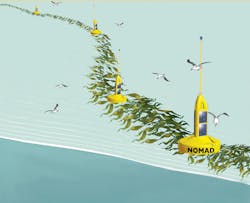Cars and trucks might one day run on biofuel made from seaweed. Or at least, they might be if engineers at the Department of Energy’s Pacific Northwest National Laboratory are successful in developing a way to mass-produce marine biomass (i.e., seaweed) that can be turned into biofuel and bio-based chemicals.
Macroalgae, the technical term for seaweed, is primarily “farm” grown for human consumption. However, it could also be used to make economically viable renewable energy without using synthetic fertilizers or the land and fresh water currently needed when considering food production. DOE estimates the U.S. could grow enough macroalgae to meet about 10% of the nation’s annual energy needs for transportation. But new technologies and innovative engineering approaches are needed to significantly increase production before cars are driving around on seaweed.
One step in boosting seaweed cultivation is knowing where to grow it. To help answer that question, a PNNL-led team is developing a set of modeling tools that will predict the best locations and times to efficiently cultivate seaweed in an open-ocean farm. The team will combine several existing modeling tools to evaluate seaweed growth potential; nutrient availability; and how natural phenomena such as wind, currents, tides, waves and storm surges could affect a manmade seaweed farm’s productivity.
This project has received $2 million in funding over the course of two years. PNNL’s Seattle office will led the project and work with colleagues from Georgia Tech, Los Alamos National Laboratory, and Oregon State University.
Another PNNL-led team will develop an autonomous cultivation device that runs along a 5-kilometer carbon-fiber rope in hopes of growing seaweed at a low cost. Free-floating buoys equipped with sensors that track position, speed of movement, underwater light exposure, and other parameters will keep the long line afloat. Data from the sensors will calculate growth of two species of kelp growing along the line. The line’s carbon fiber will be made with composite waste materials from the aviation industry. PNNL calls its system the Nautical Offshore Autonomous Device, or NOMAD.


